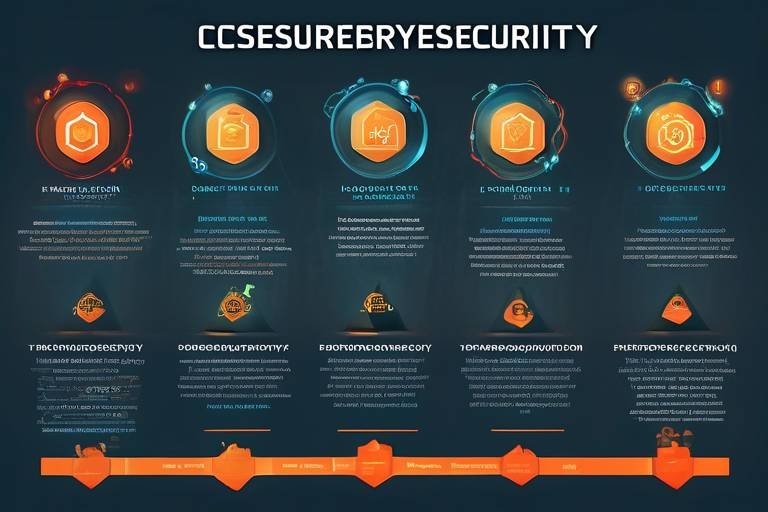Cyber Attacks - How to Respond and Recover
In today's digital landscape, the threat of cyber attacks looms larger than ever. With hackers constantly evolving their tactics, it’s crucial for both individuals and organizations to be equipped with the knowledge and tools to effectively respond and recover from these malicious incidents. Cyber attacks can disrupt operations, compromise sensitive data, and lead to significant financial losses. But fear not! Understanding the nature of these attacks and having a solid response plan can make all the difference. This article dives deep into the various types of cyber threats, outlines effective response strategies, and offers recovery methods to help safeguard your digital assets and maintain operational integrity.
Cyber attacks come in various forms, each with its own unique characteristics and motives. Some of the most common types include phishing, malware, and ransomware. Phishing involves tricking individuals into divulging personal information through seemingly legitimate emails or websites. Malware, on the other hand, refers to malicious software designed to infiltrate and damage systems, while ransomware locks users out of their data until a ransom is paid. Recognizing these threats is essential for effective prevention and response strategies. By understanding how these attacks work, you can better prepare yourself and your organization to defend against them.
When a cyber attack occurs, swift action is crucial. The first few moments can determine the extent of the damage. Here’s what you should do:
Determining the type and scope of the attack is vital. This involves analyzing logs, alerts, and user reports. For instance, if you notice unusual activity on your network, it could indicate a breach. Gathering as much information as possible allows you to understand the incident's nature and respond appropriately. Remember, the sooner you identify the attack, the better your chances of containing it.
Evaluating the impact of the attack helps prioritize recovery efforts. This includes identifying compromised data and systems to inform remediation strategies. Ask yourself questions like: What data has been affected? Which systems are down? Having a clear picture of the damage allows you to allocate resources effectively and get back on track.
Clear communication within the organization is key during an attack. Establishing a protocol for informing stakeholders can help maintain order and transparency. Consider creating a communication plan that includes:
- Designated spokespersons to relay information.
- Regular updates to keep everyone informed.
- Clear guidelines on what employees should do or refrain from doing.
By keeping everyone in the loop, you can minimize panic and ensure that everyone is working towards a common goal.
Involving cybersecurity professionals can enhance response efforts. Their expertise allows for a more thorough investigation and recovery process. Whether it’s conducting a forensic analysis or implementing advanced security measures, having experts on your side can significantly improve your chances of a successful recovery.
Recovering from a cyber attack requires a comprehensive plan. It’s not just about getting back online; it’s about ensuring that you’re stronger than before. Here are some strategies to consider:
Restoring lost or compromised data is critical. This involves utilizing backups and ensuring data integrity throughout the recovery process. Regularly scheduled backups can save you from a world of hurt. Make sure to test these backups periodically to ensure they’re functioning properly. A well-maintained backup strategy is your safety net in case of an attack.
Post-incident, organizations should reassess their security measures. Implementing stronger protocols and training can significantly reduce the risk of future attacks. Consider the following:
- Conduct regular security audits.
- Provide ongoing training for employees on recognizing threats.
- Invest in advanced security technologies.
By taking these steps, you not only protect your organization but also foster a culture of security awareness among your team.
Q: What should I do if I suspect a cyber attack?
A: If you suspect a cyber attack, immediately disconnect from the internet, inform your IT department, and begin documenting the incident.
Q: How can I protect my organization from future attacks?
A: Regular security training, strong password policies, and up-to-date software can help mitigate risks.
Q: Is it necessary to hire cybersecurity experts?
A: While not mandatory, hiring cybersecurity experts can provide invaluable assistance in both preventing and responding to attacks.

Understanding Cyber Attacks
Cyber attacks are like the digital equivalent of a break-in. Just as a burglar might pick a lock or smash a window to gain entry into your home, cybercriminals use various tactics to infiltrate your digital space. These attacks can take many forms, and understanding them is crucial for anyone looking to protect their personal or organizational data.
One of the most common types of cyber attacks is phishing. This is akin to receiving a fake letter from a bank asking you to verify your account details. Phishing attempts often come disguised as legitimate emails or messages, tricking unsuspecting users into revealing sensitive information. The statistics are alarming; according to recent studies, nearly one in every four data breaches involves phishing as a primary method of attack. It's a reminder that vigilance is essential.
Another prevalent threat is malware, which refers to any malicious software designed to harm or exploit devices. Think of it as a digital virus that can infect your computer, steal your data, or hold your files hostage. Ransomware is a specific type of malware that encrypts your files and demands a ransom for their release. Imagine waking up one morning to find all your cherished photos and important documents locked away, with a message demanding payment to unlock them. This scenario is a harsh reality for many victims of ransomware attacks.
Understanding these threats is not just about recognizing the names; it’s about grasping the implications they carry. Cyber attacks can lead to significant financial losses, reputational damage, and even legal repercussions. Organizations often face the daunting task of not only recovering from an attack but also ensuring that it doesn’t happen again. To effectively combat these threats, individuals and businesses must stay informed about the evolving landscape of cybercrime.
To illustrate the various types of cyber attacks, let’s take a look at the following table:
| Type of Cyber Attack | Description | Impact |
|---|---|---|
| Phishing | Fraudulent communication to trick users into revealing sensitive information. | Data theft, financial loss, identity theft. |
| Malware | Malicious software designed to damage or exploit devices. | Data loss, system damage, operational disruption. |
| Ransomware | A type of malware that encrypts files and demands payment for decryption. | Loss of access to critical data, potential financial losses. |
In conclusion, understanding cyber attacks is the first step in building a robust defense against them. By recognizing the different types of threats, individuals and organizations can better prepare themselves to respond effectively. Remember, in the digital world, knowledge is power, and staying informed can be your best line of defense.

Immediate Response Steps
When the storm of a cyber attack hits, the first few moments can feel like a whirlwind. It's crucial to respond swiftly and effectively to mitigate damage and regain control. The initial response can be the difference between a minor inconvenience and a catastrophic breach. So, what should you do when you realize you've been attacked? Here are the immediate steps you need to take:
First and foremost, identify the attack. This means determining the type of attack and its scope. Are you dealing with a phishing attempt that has compromised a few emails, or is it a full-blown ransomware attack that has locked down your entire system? To do this, you’ll need to dive into your security logs, alerts, and any user reports that may have come in. It’s like being a detective in your own digital world, piecing together clues to understand the nature of the incident.
Once you've gathered your clues, it's time to assess the damage. This step is crucial because it helps you prioritize your recovery efforts. You need to ask yourself: What data has been compromised? Which systems are affected? By taking stock of the situation, you can better inform your remediation strategies. Remember, not all attacks are created equal, and understanding the extent of the breach will guide your next moves.
Now that you have a clearer picture, it’s essential to communicate effectively within your organization. Clear communication is the backbone of a successful response. Establishing a protocol for informing stakeholders can help maintain order and transparency. Imagine being on a ship during a storm; if the captain doesn’t communicate the course of action, chaos ensues. Similarly, your team needs to know what’s happening and what steps to take next.
In the heat of the moment, you might be tempted to go it alone, but engaging cybersecurity experts can significantly enhance your response efforts. These professionals have the knowledge and tools to conduct a thorough investigation and recovery process. Think of them as your lifeguards in a turbulent sea, ready to pull you out of danger. Their expertise can help you navigate through the murky waters of a cyber incident, ensuring that you not only recover but also learn from the experience.
In summary, your immediate response steps should focus on identifying the attack, assessing the damage, communicating clearly, and involving cybersecurity experts. By following these steps, you can contain the breach and set the stage for effective recovery. Remember, the faster you act, the better your chances of minimizing the impact of the cyber attack.
- What should I do first if I suspect a cyber attack? Start by identifying the nature of the attack and assessing the damage.
- How can I communicate with my team during an attack? Establish a clear communication protocol to keep everyone informed and organized.
- When should I involve cybersecurity experts? As soon as you confirm an attack, it's wise to engage experts to help you manage the situation.

Identifying the Attack
When a cyber attack strikes, the first step in your response arsenal is to identify the nature and scope of the attack. Think of it like a detective piecing together clues at a crime scene. You need to analyze logs, alerts, and user reports to get a clear picture of what’s happening. This initial investigation is crucial because it helps you understand the attack's modus operandi—the specific methods and tools used by the attacker. Are they using phishing emails, or has malware infiltrated your systems?
Start by examining your system logs. These logs are like a digital diary, recording every action taken on your network. Look for any unusual activity—such as login attempts from unfamiliar IP addresses or spikes in data transfer that seem out of the ordinary. If you notice something suspicious, it’s essential to act quickly. For example, if you see multiple failed login attempts from a single user account, it could indicate a brute force attack.
Next, engage your security software. Most modern cybersecurity tools come equipped with alert systems that notify you of potential breaches. These alerts can provide valuable insight into the type of attack you're facing. For instance, if your antivirus software flags a specific file as malicious, it can help you narrow down the potential threat. However, don’t solely rely on automated systems; human intuition plays a vital role in identifying more sophisticated attacks that may slip through the cracks.
It’s also essential to gather information from your users. Encourage your team to report any strange behavior they notice on their devices. Perhaps someone received an odd email or noticed their computer running unusually slow. These reports can serve as vital clues in your investigation. To facilitate this, establish a clear communication channel for reporting incidents, ensuring that everyone feels comfortable sharing their observations.
Lastly, keep in mind that cyber attacks often come in waves. Just because you’ve identified one attack doesn’t mean others aren’t lurking in the shadows. Regularly monitor your systems even after addressing an initial breach. This ongoing vigilance will help you catch any subsequent attacks before they escalate.
In summary, identifying a cyber attack involves a combination of log analysis, security alerts, and user reports. By piecing together these elements, you can gain a comprehensive understanding of the attack and take informed action to mitigate its impact.
- What should I do if I suspect a cyber attack? Immediately gather information, analyze logs, and report the incident to your IT team or cybersecurity professionals.
- How can I tell if my data has been compromised? Look for signs of unusual activity, such as unauthorized access or changes to your files. Regular audits can help detect anomalies.
- Is it necessary to involve cybersecurity experts? Yes, their expertise can significantly enhance your investigation and recovery efforts, ensuring a thorough response to the attack.

Assessing Damage
When a cyber attack strikes, the initial shock can be overwhelming. However, amidst the chaos, it’s crucial to take a step back and assess the damage comprehensively. This process is not just about figuring out what went wrong; it’s about understanding the full extent of the impact on your organization. Imagine you’ve just experienced a flood in your home; you wouldn’t just mop up the water and call it a day. Instead, you'd want to inspect the walls, the electrical systems, and all your belongings to gauge the true cost of the disaster. Similarly, in the realm of cyber security, a thorough assessment is essential.
First and foremost, you need to identify which systems and data were compromised. This involves diving into system logs, analyzing alerts, and gathering reports from users who may have encountered issues. By piecing together these clues, you can create a clearer picture of the attack's scope. For instance, if you discover that customer data was accessed, it raises the stakes significantly. You must then prioritize your recovery efforts based on the sensitivity of the compromised information.
Next, consider the different types of damage that can occur during a cyber attack. The impact can be categorized into several areas:
- Data Loss: This includes any information that has been deleted or corrupted during the attack.
- Operational Disruption: Assess how the attack has affected your day-to-day operations. Are there systems that are completely down?
- Reputational Damage: If customer data was compromised, how might this affect your brand's reputation? Will clients trust you moving forward?
To make this assessment more systematic, consider creating a damage assessment table that outlines each compromised asset, its importance, and the estimated recovery time. Here’s a simple example:
| Asset | Type of Damage | Importance Level | Estimated Recovery Time |
|---|---|---|---|
| Customer Database | Data Loss | High | 1 Week |
| Email Server | Operational Disruption | Medium | 2 Days |
| Company Website | Reputational Damage | High | 3 Days |
Once you’ve compiled this information, it’s essential to communicate your findings to key stakeholders. Transparency during recovery not only helps maintain trust but also ensures that everyone is on the same page regarding the steps needed to move forward. Remember, the goal is not just to recover but to learn from the incident to prevent future occurrences.
In conclusion, assessing the damage after a cyber attack is a critical step in the recovery process. By understanding the full scope of the incident, you can prioritize your recovery efforts effectively and implement strategies to enhance your security posture moving forward. Just like a ship captain must assess the damage after a storm to navigate safely, organizations must do the same to protect their digital assets.
- What should I do first after a cyber attack? Start by assessing the damage to understand the extent of the breach.
- How can I prevent future attacks? Regularly update your security protocols and conduct employee training on recognizing threats.
- Is it necessary to involve law enforcement? Yes, especially if sensitive data has been compromised or if you suspect criminal activity.

Communicating Internally
In the face of a cyber attack, clear and effective communication within an organization is not just important; it's absolutely critical. Imagine trying to navigate a ship through a storm without a compass or a map. That’s what it feels like when team members are left in the dark during a crisis. Establishing a robust communication protocol can make all the difference in maintaining order, ensuring that everyone knows their role, and minimizing panic.
First and foremost, it's essential to designate a crisis communication team. This team should include key personnel from various departments such as IT, HR, and public relations. By having representatives from different areas, you ensure that all perspectives are considered and that information flows seamlessly across the organization. Regular updates from this team can help mitigate misinformation and keep everyone aligned on the current status of the incident.
Moreover, utilizing multiple channels for communication is advisable. Whether it’s through emails, instant messaging apps, or even face-to-face meetings, diversifying your communication methods can help reach everyone effectively. During a cyber attack, some systems may be down, so relying solely on one method can lead to gaps in information dissemination. For instance, consider using:
- Email Alerts: For formal updates and detailed information.
- Instant Messaging: For quick, real-time communication among staff.
- Intranet Posts: For centralized information that everyone can access at any time.
Additionally, it's vital to maintain transparency. Employees want to know what's going on, and withholding information can lead to distrust and anxiety. By being open about the nature of the attack, the steps being taken to address it, and the potential impacts, you empower your staff to be part of the solution. This approach not only fosters a culture of trust but also encourages employees to report any suspicious activities they might observe.
Finally, after the initial response, don’t forget to debrief. Once the dust settles, gather the team to discuss what happened, what went well, and what could be improved. This not only helps in refining your communication strategy for future incidents but also reinforces the idea that everyone plays a role in the organization’s security posture. Remember, communication during a crisis is like the glue that holds a team together; without it, you risk falling apart.
Here are some common questions regarding internal communication during a cyber attack:
| Question | Answer |
|---|---|
| What should I do if I receive suspicious emails during an attack? | Immediately report them to your IT department and avoid clicking any links or downloading attachments. |
| How often should updates be communicated to staff? | Updates should be provided regularly, at least every few hours, or as new information becomes available. |
| Who should be part of the crisis communication team? | Key personnel from IT, HR, public relations, and any other relevant departments should be included. |

Engaging Cybersecurity Experts
When a cyber attack strikes, the chaos can feel overwhelming, like being caught in a storm without an umbrella. This is where the expertise of cybersecurity professionals becomes invaluable. Engaging these experts isn’t just a smart move; it’s a necessity for effectively navigating the turbulent waters of a cyber incident. They bring a wealth of knowledge and experience that can make all the difference in how swiftly and effectively you respond to the threat.
First and foremost, cybersecurity experts can help you identify the nature of the attack. They possess the tools and skills to analyze data logs, assess network traffic, and pinpoint vulnerabilities that may have been exploited. Imagine them as detectives, sifting through clues to uncover the perpetrator’s methods and intentions. This analysis is crucial not only for immediate response but also for understanding how to fortify your defenses moving forward.
Moreover, these professionals can assist in developing a tailored incident response plan. This plan is akin to having a fire drill in place; it prepares your organization for rapid action when the alarm sounds. A well-structured incident response plan includes clearly defined roles and responsibilities, ensuring that everyone knows what to do and who to turn to when the crisis hits. This minimizes confusion and helps maintain order during a chaotic time.
In addition to immediate response, cybersecurity experts play a significant role in the recovery phase. They help in restoring systems and data efficiently, ensuring that your organization can return to normal operations as quickly as possible. Their expertise in data recovery techniques can be the difference between a minor setback and a catastrophic loss. They can guide you through the process of using backups, verifying data integrity, and implementing measures to prevent future incidents.
Furthermore, engaging with cybersecurity experts opens the door to ongoing support. Think of it as having a personal trainer for your digital security. They can provide continuous monitoring, regular assessments, and employee training, ensuring that your organization remains vigilant against evolving threats. With cyber threats constantly changing, having a dedicated team of experts at your side is like having a seasoned navigator on a ship sailing through treacherous waters.
Finally, it’s important to choose the right cybersecurity partner. Look for firms that not only have a proven track record but also understand your specific industry and its unique challenges. A good cybersecurity expert should be able to communicate effectively, translating complex technical jargon into actionable insights that everyone in your organization can understand. After all, effective communication is key to a successful partnership.
- What qualifications should I look for in a cybersecurity expert? Look for certifications such as CISSP, CISM, or CEH, as well as relevant experience in your industry.
- How can I ensure my organization is prepared for a cyber attack? Regular training, a solid incident response plan, and continuous monitoring are essential.
- What is the average cost of engaging cybersecurity experts? Costs can vary widely based on the services required, so it's best to get quotes from multiple providers.
- Can cybersecurity experts help with compliance issues? Yes, they can guide you through regulations and ensure your organization meets necessary compliance standards.

Long-term Recovery Strategies
Recovering from a cyber attack is not just about putting out the fire; it’s about rebuilding the entire structure to ensure it’s more resilient than before. Organizations must adopt a comprehensive recovery plan that addresses both immediate needs and long-term security enhancements. This process is akin to a phoenix rising from the ashes, where the goal is to emerge stronger and more secure.
One of the first steps in long-term recovery is to focus on data restoration techniques. This involves not only recovering lost or compromised data but also ensuring that the integrity of the data is maintained throughout the recovery process. Organizations should have a robust backup system in place that allows for quick restoration. This means regularly scheduled backups, which can be stored both on-site and in the cloud. By diversifying backup locations, you minimize the risk of losing everything in a single point of failure. Here’s a simple table to illustrate different backup strategies:
| Backup Type | Description | Pros | Cons |
|---|---|---|---|
| Full Backup | Complete copy of all data | Easy recovery | Time-consuming and storage-intensive |
| Incremental Backup | Backs up only data changed since the last backup | Efficient use of storage | Longer recovery time |
| Differential Backup | Backs up data changed since the last full backup | Faster recovery than incremental | More storage than incremental |
But recovery doesn’t stop at data restoration. It’s essential to strengthen the security posture of the organization post-incident. This means reassessing existing security measures and implementing stronger protocols. Think of it as fortifying a castle after a siege; you wouldn’t want to leave any weak points exposed. This could involve upgrading firewalls, implementing advanced threat detection systems, and conducting regular vulnerability assessments.
Moreover, training employees is a critical aspect of long-term recovery. Cybersecurity is not just the responsibility of the IT department; it’s a collective effort. Organizations should invest in cybersecurity awareness training for all employees. This training should cover topics such as recognizing phishing attempts, understanding the importance of strong passwords, and knowing how to respond in case of a suspected security breach. By empowering employees with knowledge, you create a human firewall that complements technological defenses.
Finally, it’s vital to establish a culture of continuous improvement. After recovering from an attack, organizations should regularly review and update their incident response plans. This means conducting post-mortem analyses to understand what went wrong and how to prevent similar incidents in the future. Just like athletes review game footage to improve their performance, businesses must analyze their responses to cyber attacks to enhance their defenses.
- What is the first step after a cyber attack? The first step is to contain the breach and assess the damage to understand the extent of the attack.
- How can I ensure my data is safe? Regular backups, strong passwords, and employee training are essential to safeguard your data.
- What should I do if I suspect a cyber attack? Immediately inform your IT department, isolate affected systems, and begin an investigation.
- How often should I update my cybersecurity protocols? Regular reviews and updates should be conducted at least annually or after any significant incident.

Data Restoration Techniques
In the aftermath of a cyber attack, one of the most pressing concerns is the restoration of lost or compromised data. This process is not just about getting back what was lost; it’s about ensuring that the data is accurate, secure, and fully functional. The first step in effective data restoration is to utilize comprehensive backups. Regularly scheduled backups can serve as a lifesaver, allowing organizations to revert to a point before the attack occurred. However, it’s crucial to ensure that these backups are stored securely and are not also compromised during the attack.
One effective technique for data restoration is the incremental backup approach. This method involves backing up only the data that has changed since the last backup. Not only does this save time, but it also reduces the amount of storage needed. In contrast, a full backup captures everything, which can be overwhelming and time-consuming to restore. While both methods have their advantages, understanding your organization’s needs will help determine which approach is best suited for your recovery strategy.
Another crucial aspect of data restoration is verifying the integrity of the data being restored. This means checking that the data is not corrupted and that it matches the expected values. Organizations can implement checksums or hashes to confirm data integrity. For example, before and after restoration, running a checksum can help identify any discrepancies that might indicate corruption or tampering.
To further enhance the restoration process, organizations should develop a comprehensive data recovery plan. This plan should include:
- Identifying critical data and prioritizing its restoration
- Establishing a timeline for recovery
- Assigning roles and responsibilities to team members
- Testing the restoration process regularly to ensure efficiency
Finally, it’s essential to document the entire restoration process. This not only helps in understanding what went wrong during the attack but also serves as a valuable resource for future incidents. By keeping thorough records, organizations can refine their strategies and improve their response capabilities over time.
Q: How often should I back up my data?
A: It is generally recommended to back up data at least once a day, but this can vary based on the volume of data and how often it changes. Critical data may require multiple backups throughout the day.
Q: What should I do if my backups are also compromised?
A: If you suspect that your backups are compromised, it's essential to disconnect them from your network immediately. Assess the situation and consult with cybersecurity professionals to determine the safest course of action.
Q: Can I restore data from a ransomware attack?
A: Yes, if you have reliable backups that were not affected by the ransomware, you can restore your data. However, it's crucial to assess the situation to ensure that the ransomware is fully eradicated before restoring any data.
Q: What tools can I use for data restoration?
A: There are various data recovery tools available, such as Acronis, EaseUS Data Recovery, and Stellar Data Recovery. However, the choice of tool should depend on the specific needs of your organization and the nature of the data loss.

Strengthening Security Posture
After surviving a cyber attack, the last thing you want is to feel vulnerable again. It's like surviving a storm only to realize your house still has holes in the roof. Strengthening your security posture is about shoring up those vulnerabilities and building a fortress around your digital assets. This isn’t just about slapping on a few new software updates; it’s a comprehensive approach that requires diligence, strategy, and, most importantly, a shift in mindset.
First and foremost, it’s essential to conduct a thorough security assessment. This means evaluating your current security measures and identifying any gaps. Think of it like a health check-up for your organization’s cybersecurity. You’ll want to analyze everything from firewalls to employee training programs. By pinpointing weaknesses, you can develop a targeted action plan to address them.
One effective way to enhance your security posture is through the implementation of multi-factor authentication (MFA). This adds an extra layer of security by requiring users to provide multiple forms of verification before accessing sensitive information. It’s like needing both a key and a password to unlock a safe. Even if a hacker manages to steal a password, they still can’t get in without the second factor.
Another crucial aspect is employee training. Your staff is your first line of defense, and if they’re not equipped with the knowledge to recognize threats, they could inadvertently become the weak link in your security chain. Regular training sessions can empower employees to identify phishing attempts, understand the importance of strong passwords, and follow best practices for data handling. You wouldn’t send soldiers into battle without proper training, so why would you do the same with your workforce?
Additionally, consider adopting a zero-trust security model. This approach operates on the principle that no one, whether inside or outside the organization, should be trusted by default. Every request for access should be verified, regardless of the source. This model can significantly reduce the risk of internal threats and limit the damage caused by external breaches.
Lastly, regularly updating your software and systems is non-negotiable. Cybercriminals are constantly developing new methods to exploit vulnerabilities, and outdated software is like leaving the door wide open. Establish a routine for monitoring and applying updates to all your systems, ensuring that you’re always one step ahead of potential threats.
In summary, strengthening your security posture requires a multifaceted approach that includes:
- Conducting regular security assessments
- Implementing multi-factor authentication
- Providing employee training
- Adopting a zero-trust security model
- Regularly updating software and systems
By taking these steps, you can create a resilient security framework that not only protects your organization from future attacks but also fosters a culture of security awareness among your employees. Remember, in the world of cybersecurity, it’s better to be proactive than reactive.
Q: What is a security assessment?
A: A security assessment is a comprehensive evaluation of an organization’s security measures, identifying vulnerabilities and areas for improvement.
Q: Why is multi-factor authentication important?
A: Multi-factor authentication adds an extra layer of security, making it harder for unauthorized users to gain access even if they have stolen a password.
Q: How often should employee training be conducted?
A: Employee training should be conducted regularly, at least once a year, and updated whenever new threats or technologies emerge.
Q: What does a zero-trust security model entail?
A: A zero-trust security model assumes that no one should be trusted by default, requiring verification for every access request, regardless of the source.
Q: Why is software updating crucial for security?
A: Regular software updates fix known vulnerabilities and protect against new threats, keeping your systems secure from potential attacks.
Frequently Asked Questions
- What are the most common types of cyber attacks?
Cyber attacks can take many forms, but some of the most common include phishing, where attackers trick users into revealing sensitive information; malware, which involves malicious software designed to harm or exploit systems; and ransomware, where attackers encrypt data and demand payment for its release. Understanding these threats is crucial for effective prevention.
- How can I quickly respond to a cyber attack?
When faced with a cyber attack, the first step is to identify the nature of the attack. This involves analyzing logs and alerts to understand what has happened. Next, you should contain the breach by isolating affected systems. Communicating clearly with your team is also essential to maintain order and transparency during the chaos.
- What should I do if I suspect a data breach?
If you suspect a data breach, act swiftly! Start by assessing the damage to understand what data may have been compromised. Immediately notify your internal security team and consider engaging external cybersecurity experts to conduct a thorough investigation and help with recovery.
- How can I recover lost data after a cyber attack?
Recovering lost data typically involves utilizing backups that were made before the attack occurred. It's crucial to ensure that these backups are not also compromised. Implementing a robust data restoration plan can help restore functionality while maintaining data integrity throughout the recovery process.
- What long-term strategies can help prevent future cyber attacks?
To prevent future attacks, organizations should regularly assess their security posture. This includes updating security protocols, investing in advanced cybersecurity technologies, and conducting employee training to raise awareness about potential threats. A proactive approach can significantly reduce the risk of future incidents.
- Is it necessary to hire cybersecurity professionals?
While not always necessary, involving cybersecurity professionals can greatly enhance your response efforts during and after a cyber attack. Their expertise allows for a more thorough investigation, helping to identify vulnerabilities and implement effective recovery strategies.



















